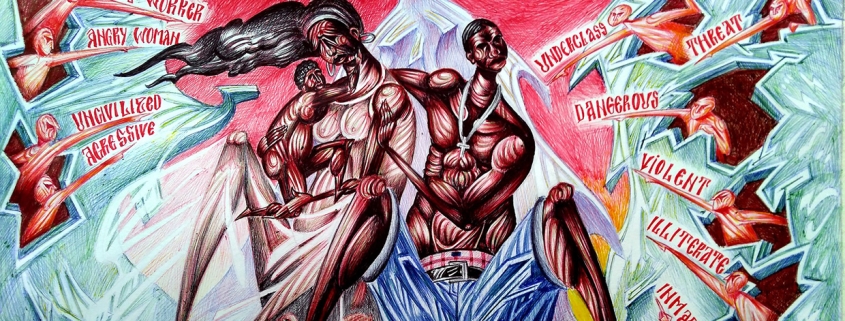GRADUATION HIGHLIGHTS 2020
Various Artists
STATEMENT
In the series of works How Dare You?, Nina Cucuietu (whose bachelor’s thesis was coordinated by Tudor Pătrașcu, PhD Assistant Professor) explores the impact of the anthropogenic factor on the ecological balance and the consequences of this phenomenon on future generations. The project includes 8 digital collages and investigates topics such as deforestation, toxic gas emissions from accelerated urbanization and industrialization, endangering the terrestrial, aquatic and aerial biosphere, and the social attitude towards these phenomena. The topicality and importance of these issues is underlined by the visual constants of representation, such as ambiguous backgrounds, anatomical elements of the human body and the association of black and white photographs and colour images.
Daniel Doboș (whose dissertation was coordinated by Ramona Biciușcă, PhD Assistant Professor) conducts a research exercise dedicated to fantastic, imaginary places and characters. The two organomorphic works from the Enuma Elish cycle are inspired by the intrinsic behaviour of ceramic materials. Each character fits into a narrative form of organic nature and follows the structure of an anthropomorphic-zoomorphic identity. The matte, rough glazes make the subtle transition from the palpable to the supersensitive, imaginary plane.
The paintings made by Emi Grigoraș (whose dissertation was coordinated by Cristian Ungureanu, PhD Associate Professor) symbolically transpose the dystopian registers of phobias, kenophobia – fear of empty, boundless spaces without landmarks – and demophobia – the fear of crowds in public spaces. The two landscapes, seemingly imaginary, enter into a dialogue of psycho-somatic spaces that disturbs the empathic viewer, so confronted, in a rough comparison, with the deserted reality of intimacy and urbanity of today.
In its initial conception, the pictorial installation proposed by Ioana Irimia (whose dissertation was coordinated by Cristian Ungureanu, PhD Associate Professor) includes thirty-nine works painted in acrylic on canvas, in circular format (of which 9 pieces are exhibited at Borderline Art Space and 30 pieces are on display in the Habitat Proiect Building), illustrating the steps of the ladder of spiritual evolution and the stages of human development before birth. The circularity of the canvases refers to the contradictory cyclicity, both finite and infinite, unitary and multiple, of the biological and spiritual evolution of the human being. Ioana Irimia refers to the writings of Saint John of the Ladder, which present the spiritual pathway of thirty steps that symbolize virtues and vices, with ascending and descending functions and results in human evolution.
In the ECO 2.0 series of works, Vilen Maftei (whose dissertation was coordinated by Ioan Pricop, PhD Assistant Professor) is engaged in an iconographic reconceptualization of the global ecological disaster. If in the work Water and animals water pollution and the widespread extermination of animals are transformed into visual messages by juxtaposing aquatic animals over fragments of mountainous landscape, thus invoking an inadequacy of survival by overturning habitats, in the work Garbage images taken from the Great Pacific Garbage Patch from the Pacific Ocean, discovered in 1997 and considered a “sinister continent of the 21st century”, overlap with fragments of documented images from countries facing the residual effects of consumerism.
Florin Niga (whose dissertation was coordinated by Dan Acostioaei, PhD Associate Professor) proposes two series of works, one with a religious theme, and a secular one, thus referring to two concepts that formed the basis of the artwork, the first being the desire to bring forward the art of the Byzantine style, and the second to create a critical image of contemporary society. Thus, the technique is specific to graphics (coloured pen on paper), both to try new ways of working in the Byzantine manner, and to highlight the authenticity and bring an innovation in Byzantine art.
The project of the eco-sculptural installation Regenerated Human (made in mixed media, watercolour, pencil and liner on paper) is the basis of an artistic research by Flavia Pintea (whose dissertation was coordinated by Cătălin Gheorghe, PhD Associate Professor), presenting the prototype of a hydraulic sculptural ensemble, with self-sustaining qualities, which generates oxygen and helps with nitrogen fixation in the air composition. In symbolic order, the project proposes a reversal of the relationship between man and nature by simulating the feeding of the natural environment by man and overcoming the unilateralism of the consumption of natural elements in strictly human interest. In material order, the project is based on a biological processing technology of chitin (a polysaccharide that gives resistance to insect and crustacean exoskeletons) whose transparency capacity allows sunlight to interfere with the cyanobacteria culture in the basin where the sculpture generating oxygen through the nanofibers inserted inside it is installed.
In her series of works, Mădălina Rusu (whose bachelor’s thesis was coordinated by Tudor Pătrașcu, PhD Assistant Professor) presents the sad image of a group of financially disadvantaged people, a situation resulting from the pronounced inequalities between social classes. As this is a pressing issue faced by most European states, she opts to carry out the work in a hyperrealistic way, so as not embellish this problem in any way. By preparing this project, Rusu Mădălina wants to highlight the poverty stage of the social classes deeply marked by precariousness, with the help of visual images of the actions they have to resort to.

